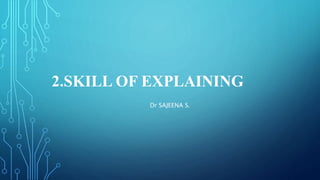
Microteaching skill of expalining
- 1. 2.SKILL OF EXPLAINING Dr SAJEENA S.
- 2. 2.SKILL OF EXPLAINING • A teacher has to learn the skill of explaining in order to make the pupils understand many ideas, concepts or principles that need explanation. Explanation is nothing but a few interrelated appropriate statements. Thus, the skill of explaining may be defined as an art of learning the use of interrelated appropriate statements by the teacher for making the pupils understand the desired concept, phenomenon or principle. It is a verbal skill and has two main aspects:
- 3. • i) The selection of appropriate statements relevant to the age, maturity, previous knowledge, and content of the concept or phenomenon. • (ii) The skill of interrelating and using the selected statements for the proper understanding of the concept or phenomenon. • The statements are generally of three types: the descriptive, the interpretive, and the reason giving (usually meant for answering the questions: how, what. and why of concept or phenomenon or principle).
- 4. • Components of the skill • The skill of explaining a concept or phenomenon consists of two types of behaviour- desirable and undesirable. In the practice of the skill, the occurrence of the desirable behaviour is to be increased whereas that of the undesirable behaviour is to be decreased and extinguished.
- 5. • Desirable behaviours • 1. Using appropriate beginning and concluding statements: The beginning statement is an opening statement announcing what is going to be explained by the teacher. It prepares the pupil mentally to receive the explanation. On the other hand, the concluding statements are made after the end of the explanation in order to summarize or conclude the whole explanation
- 6. • • 2. Using explaining links: The explaining links in the form of words and phrases are meant for establishing links or continuity in the statements used for explaining a concept, phenomenon or principle. Some of these linking words and phrases generally used for explaining are: therefore, hence, thus, consequently, since, because, so that, in spite of, as a result of, the function of the purpose of, the cause of, due to, that is why, this is how, in order to, in order that, on the other hand, why, while, etc.
- 7. • 3. Covering essential points: The explanation given for the understanding of a given concept or principle should be as complete as possible. The completeness is determined by the scope of the concept or principle as specified in the instructional objectives. It should aim for covering all the essential points leading to clear understanding of the desired concept or principle.
- 8. • 4.Testing pupil's understanding: This involves asking appropriate questions to pupils to ascertain whether the purpose of explaining the concept or principle has been achieved or not.
- 9. • Undesirable behaviours • 1. Using irrelevant statements: This behaviour covers the statements not related to the concept or principle being explained. These statements, instead of helping the pupil to understand the concept, create confusion and distract the attention of the pupil • 2. Lacking continuity in statements: It involves a missing link or break in the logical sequence of the interrelated statement by the teacher for explaining a concept or phenomenon
- 10. • 3. Lacking fluency: Fluency is related to the flow of uninterrupted statements for explaining a concept or principle. In case a teacher lacks fluency, he may be seen to show following types of behaviours: Does not speak clearly. Utters incomplete or half sentences Tries to reformulate or correct his statements midway of a sentence or a statement Uses fumbling ideas or inappropriate words or statements.
- 11. • 4. Using inappropriate vocabulary, vague words and phrases: This behaviour consists of the following aspects: • (i) Use of vocabulary not known to pupils or inappropriate to their age, grade maturity level • (ii) Use of certain vague words and phrases (such as, in fact, somewhat, you see, you know, I mean, actually, probably, perhaps, and almost a little) obstructing the understanding of an explanation.
- 12. Name of the Student teacher: Concept/Topic: Date: Subject: Session: Teach/Re-teach Supervisor: Tallies for Specific Observations Components Rating scale Desirable Behaviours Extended to extremely weak to excellent Yes/No Yes/No Tallies Yes/No Yes/No 1.Using appropriate beginning statements 2. Using appropriate concluding statements 3. Using explaining links 4. Covering essential points 5. Testing pupils understanding 0 1 2 3 4 5 6 0 1 2 3 4 5 6 0 1 2 3 4 5 6 0 1 2 3 4 5 6 0 1 2 3 4 5 6
- 13. Undesirable Behaviours Not at all-very much Tallies Tallies Yes/No Tallies Tallies 1.Using irrelevant statements 2.Lacking continuity in statements 3. Lacking fluency 4.Using inappropriate vocabulary 5. Using vague words/phrases 0 1 2 3 4 5 6 0 1 2 3 4 5 6 0 1 2 3 4 5 6 0 1 2 3 4 5 6 0 1 2 3 4 5 6